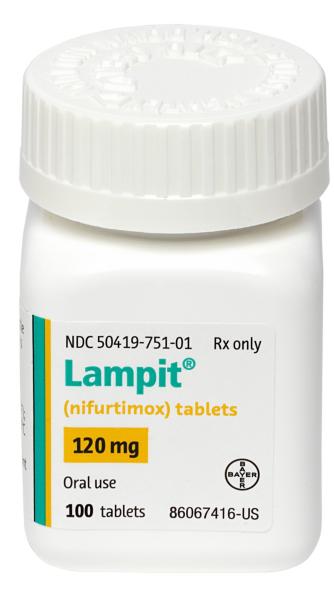Lampit Disease Interactions
There are 5 disease interactions with Lampit (nifurtimox).
Nifurtimox (applies to Lampit) alcohol
Major Potential Hazard, Moderate plausibility. Applicable conditions: Alcoholism
The consumption of alcohol is contraindicated when receiving treatment with nifurtimox as it may increase the incidence and severity of adverse events.
Nifurtimox (applies to Lampit) liver dysfunction
Moderate Potential Hazard, Moderate plausibility. Applicable conditions: Liver Disease
The effect of hepatic impairment on the pharmacokinetics of nifurtimox is unknown. Administer under close medical supervision on these patients.
Nifurtimox (applies to Lampit) neurological/psychiatric conditions
Moderate Potential Hazard, Moderate plausibility. Applicable conditions: Seizures, Head Injury, History - Psychiatric Disorder
Patients with a history of brain injury, seizures, psychiatric disease or behavioral alterations may experience worsening of their conditions when receiving treatment with nifurtimox. This drug should be administered under close medical supervision in these patients.
Nifurtimox (applies to Lampit) porphyria
Moderate Potential Hazard, Moderate plausibility.
Treatment with nifurtimox may precipitate attacks of porphyria and should be used under close medical supervision in patients with this diagnosis.
Nifurtimox (applies to Lampit) renal dysfunction
Moderate Potential Hazard, Moderate plausibility.
The effect of renal impairment on the pharmacokinetics of nifurtimox is unknown, but studies suggest that the blood concentrations of the drug are increased in patients with end-stage renal disease that require hemodialysis. Administer under close medical supervision on these patients.
Switch to professional interaction data
Lampit drug interactions
There are 12 drug interactions with Lampit (nifurtimox).
Lampit alcohol/food interactions
There is 1 alcohol/food interaction with Lampit (nifurtimox).
More about Lampit (nifurtimox)
- Lampit consumer information
- Check interactions
- Compare alternatives
- Pricing & coupons
- Drug images
- Side effects
- Dosage information
- During pregnancy
- FDA approval history
- Drug class: miscellaneous antibiotics
- Breastfeeding
- En español
Related treatment guides
Drug Interaction Classification
| Highly clinically significant. Avoid combinations; the risk of the interaction outweighs the benefit. | |
| Moderately clinically significant. Usually avoid combinations; use it only under special circumstances. | |
| Minimally clinically significant. Minimize risk; assess risk and consider an alternative drug, take steps to circumvent the interaction risk and/or institute a monitoring plan. | |
| No interaction information available. |
See also:
Further information
Always consult your healthcare provider to ensure the information displayed on this page applies to your personal circumstances.


